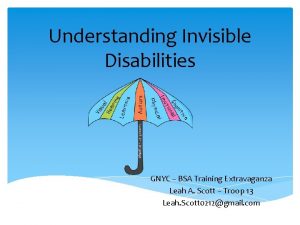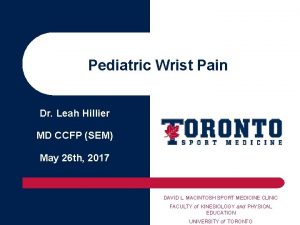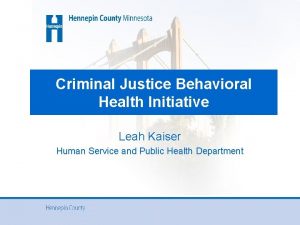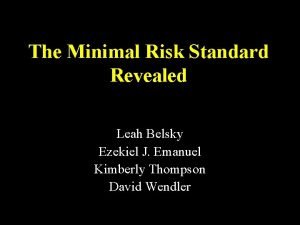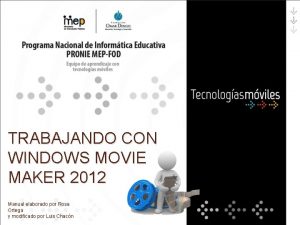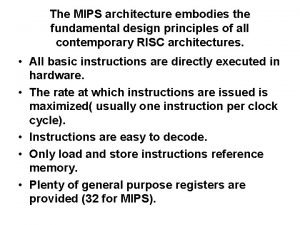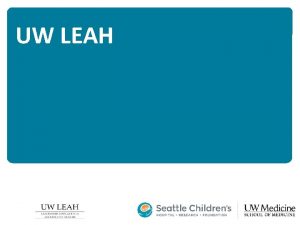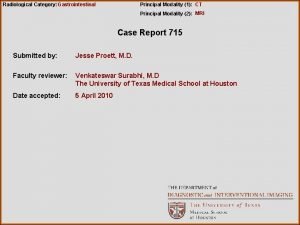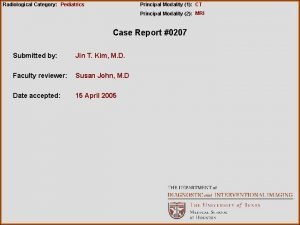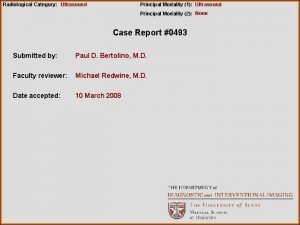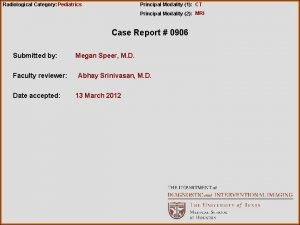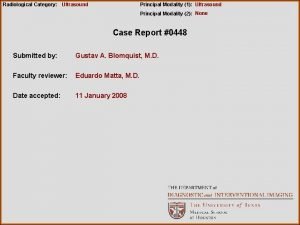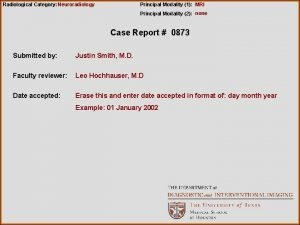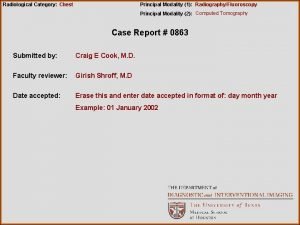LEAH C MALOF PRINCIPAL Leah Malof is a




































- Slides: 36

LEAH C. MALOF PRINCIPAL Leah Malof is a principal in Mercer’s Employee Health & Benefits business, as well as a consultant in Mercer’s national Analytic and Measurement specialty practice. Leah brings practicality to her consulting, engaging all the influential parties within the health care ecosystem toward common goals that centers around her clients. Leah uses a variety of data sets and systems in her client work, transforming data to actionable strategy and driving high-integrity, objective decision making. Specific experience includes: utilization and complex and catastrophic case management, disability management, wellness and chronic disease management, medical claims management, centers of excellence program selection and implementation, incentive design and communications. Her consulting work further includes leveraging data to answer fundamental questions such as what unique factors exist that can drive a specific and measurable strategy, such as the influence of generation, access, and culture. She has coordinated and led focus groups, vendor summits, and collaborated with communication resources to develop highly customized multimedia health promotion content. She leverages her data and broad healthcare experience to develop partnerships with vendors and client centered performance guarantees. And finally, Leah has a particularly strength in tying health and performance to the impact it has on her client’s business objectives. Leah has more than 25 years of experience within the health care industry. Prior to joining Mercer, she was the Practice Leader for Buck Consultants’ Center of Excellence for Health Analytics and Interventions. She managed national consulting teams providing services that ranged from custom data dashboard development and analytics, to multi-functional audits, and population health and wellness consulting. Leah played an instrumental role in the development and ongoing operations of Buck’s private exchange solution, and also served as the interim Health and Productivity Practice Leader in the UK. Leah’s health care industry experience also includes her work as a clinician, specializing in brain injury rehabilitation, with a specific focus on metacognition and assisting professionals and college students in returning to work and school. She leverages her clinical expertise in human behavior and decision making to help drive meaningful change in her consulting work. Leah also served as a director of various outpatient facilities and was a senior executive of a third-party administrator directly responsible for comprehensive medical operations to support claims administration and a full continuum of integrated care management programs and services. Leah has a Masters in speech pathology specializing in neurology from Indiana University and a BA in psychology from Emory University.

HEALTH WEALTH CAREER Is Wellness Working? How to make the most from the deluge of data May 8, 2017 1

Wellness is…. “the active process through which people become aware of and make choices toward a successful existence” -National Institute of Wellness © MERCER 2017 2

IS HEALTH A BUSINESS ISSUE? 345% 350 % CHANGE 325% 300 250 235% 200 159% 150 100 50 0 2001 2004 2007 2010 2013 -50 Koop HERO CHAA S&P 500 Source: Mercer's Inside Employees' Minds Survey, 2015; Journal of Occupational and Environmental Medicine, January 2016 © MERCER 2017 3

IS HEALTH A BUSINESS? Big Data Analytics ial anc ing n i F lbe l We Physical ellness Activity/W Medica l Devices cy Tr W Nu eig tri ht tio / n en cy on Be ini nd 2 Op ha He vior alt al h th al e e. H l Te Coo Broad e Car tion a rdin Co nd Mg ition mt. rma an sp ar p ee Sl Advocacy Navigation / Onsite Near-s Pregn anc / Fam y ily Pha Incentives/Challenges Assessments/Testing © MERCER 2017 Employer-Sponsored/Exchange Healthy Habits MEMBER Provider Networks Smoking Communications 4

HOW IS THE BUSINESS DOING? © MERCER 2017 5

HOW IS THE BUSINESS DOING? One in three babies born in the US in the year 2000 will be diabetic © MERCER 2017 6

IS WELLNESS WORKING? HOW TO MAKE THE MOST OF THE DELUGE OF DATA © MERCER 2017 7

FIVE PRIMARY CHALLENGES 1. Too much / too little / not the right data 2. Data that doesn’t tell a Data story or answer fundamental questions 3. Data that is repetitive and shows what is already known Information 4. Not enough evidence of value or effectiveness or proof 5. The “now what”? is not evident Insights Action © MERCER 2017 8

FOUR PRIMARY QUESTIONS Ø Do we have the information we need to answer our questions? Ø Based on the information we have, what insights can we glean? Ø Based on the insights what action should we take? Ø Is there anything else we need to know or should consider when deciding on what action to take? © MERCER 2017 9

WHERE’S THE DATA? VALUE Measurement Strategy VENDOR PARTNERS BASIC DATA WAREHOUSE ADVANCED DATA WAREHOUSE Direct or Delegated © MERCER 2017 10

BUILD A MEASUREMENT STRATEGY What questions do we want the data to answer? Who is or are the Recipient(s) of the information? © MERCER 2017 What metrics will answer our questions? How do we define success? What format will tell the story best to each recipient? What frequency is needed? What data do we have, what do we need, where TEXT will we get it and what’s our budget? What actions do you expect the audience(s) to take based on the data? 11

STRATEGIC FORMULA Desired Change or Success Access to Resources and Information Motivation Influencers © MERCER 2017 12

DEFINE DESIRED SUCCESS OR CHANGE Clinical • Prevalence • Biometrics • Illness Burden or population risk Utilization Adherence • Choice • Participation • Evidence Based Medicine • Safety and Other Policies Operational • • Contracts Plan Design Compliance Claims Processing • Recruitment • Retention Financial • Cost • Productivity Business Performance • Personal finance Behavior • • Perceptions Culture Values Generational or other meaningful segmentation Physical, Financial and Emotional Well Being Human Capital Optimization Promotion Wellness Total Well Being Human Performance Maintenance Sustainability © MERCER 2017 13

SAMPLE • Increase diabetics medication possession ratio with retail/mail order to reach benchmarks Define Change Success • Increase utilization of HPN designated providers where available to 50% • Improve or achieve “healthy” biometric values for 80% of engaged diabetics • Less inpatient admissions, readmissions and emergency rooms visits when comparing engaged to non engaged • Lower overall medical and pharmacy costs than non engaged diabetics Define Resources, Programs, Interventions & Messages CURRENT • In network high performance providers available • & Motivation to Drive Action © MERCER 2017 Incentives: engaged participants receive free generic maintenance medication and free glucometer and test strips and $100 gift card; pay for performance for primary care providers Consider Incentives Resources: Disease Management Program – multi modality and 24/7 access; ACTIONS NEEDED • Clearly define engaged for the purposes of reporting on success criteria • Verify coaches can identify HPN providers and promote steerage • Align performance guarantees with diabetes vendor 14

BUILD A MEASUREMENT STRATEGY What questions do we want the data to answer? Who is or are the Recipient(s) of the information? © MERCER 2017 What metrics will answer our questions? How do we define success? What format will tell the story best to each recipient? What frequency is needed? What data do we have, what do we need, where TEXT will we get it and what’s our budget? What actions do you expect the audience(s) to take based on the data? 15

“If we give everyone the right amount of nutrition and exercise, not too little and not too much, we would have found the safest way to health” - ? ? ? © MERCER 2017 16

QUESTIONS AND ANSWERS Mercer Local Consulting Team Ann Thomas 801 -533 -3669 © MERCER 2017 Rob Benda 801 -533 -3631 Sean Liedtke 801 -533 -3621 Krystle Hilbig 801 -533 -3657 17

© MERCER 2017 18

HEALTH WEALTH CAREER Is Wellness Working? A Case Study May 9, 2017 19

YOUR WORKSHEET Question How will and/or how does your client define success? See slide from the 5 -8 -17 presentation What questions do you have? Can your questions be defined objectively? Do you have the data you need? Who is the audience for the information? How will you display it to tell a story? What frequency is needed? What action do you expect to take based on this information? © MERCER 2017 20

THE PROCESS OF DESIGN Wellness Program IS WELLNESS WORKING? FINANCIAL UTILIZATION ADHERENCE CLINICAL Lower Claim Expense Less Utilization of High Cost Services Fewer Gaps in Care Maintain and/or Improve Biometric Health ACTION Leverage results to enhance program effectiveness and identify other opportunities © MERCER 2017 COPYRIGHT MERCER 2015 21

ACCESS TO DATA VALUE MEASUREMENT STRATEGY VENDOR PARTNERS BASIC DATA WAREHOUSE ADVANCED DATA WAREHOUSE DIRECT OR DELEGATED © MERCER 2017 22

DEFINITIONS AND TERMS Participant Medical Plan Enrollment Relationship Health Risk Assessment/ Biometric Results Medical and Pharmacy Claims Experience Member Count Plan © MERCER 2017 Non-Participant Three consecutive years of enrollment Employees and Spouses Three years of HRA/Biometric participation None 36 months of consecutive incurred claims experience (2013, 2014, 2015) 1, 182 480 No consideration given to plan design. Consumer directed plan added in 2014 with minimal enrollment 23

FINANCIAL ALLOWED PMPY: WITH AND WITHOUT HCC Allowed Amt - Med & Rx (PMPY) $9, 000 $8, 000 $7, 000 $6, 000 $5, 000 $4, 000 $3, 000 $2, 000 $1, 000 $0 HCC Adjusted ($50 K) $7, 491 $9, 000 $6, 397 $5, 257 $4, 985 Lower Claim Expense $5, 365 $5, 279 $8, 000 $7, 000 $6, 000 $5, 124 $5, 266 $4, 834 $4, 433 $4, 454 $4, 703 $4, 000 Year 1 Participant Year 2 Year 3 Non-Participant (0 year) • On a PMPY basis, Participant healthcare costs were less than Non-Participants in two of the three years and essentially the same in Year 3 • When high cost claims (HCC), defined as $50, 000 or greater, are removed, the Participant PMPY allowed amount was less than Non-Participants in all three years © MERCER 2017 Incurred Aug 2013 – July 2014 (Year 1), Aug 2014 – July 2015 (Year 2) and Aug 2015 – July 2016 (Year 3) 24

INPATIENT ADMISSIONS UTILIZATION Less Utilization of High Cost Services • Participants had lower IP/1000 than Non-Participants in all three years and are 29 percentage points further below benchmark than the Non-Participant group © MERCER 2017 Incurred claims from Aug 2013 – July 2014 (Year 1), Aug 2014 – July 2015 (Year 2) and Aug 2015 – July 2016 (Year 3) 25

UTILIZATION EMERGENCY ROOM Less Utilization of High Cost Services % Non-Emergent ER Visits (Per 1, 000) 300 250 30% 250 100 23% 25% 200 150 28% 27% 167 154 128 99 87 20% 22% 17% 15% 10% 50 5% 0 Year 1 Year 2 Participant Year 3 Non-Par. (0 years) 0% Year 1 Year 2 Participant Year 3 Non-Par. (0 years) • Participants had lower Emergency Room (ER) Visits/1000 than Non-Participants in all three years • The Participants has a lower percentage of ER visits classified as non-emergent in all but the first year of the analysis © MERCER 2017 Incurred claims from Aug 2013 – July 2014 (Year 1), Aug 2014 – July 2015 (Year 2) and Aug 2015 – July 2016 (Year 3) 26

ADHERENCE PREVENTIVE CARE SCREENING RATES Breast Cancer Screening 80% 70% 60% 50% 40% 30% 20% 10% 0% Participant Non-Par. (0 years) Year 1 65% 46% Year 2 67% 38% Year 3 58% 41% Colon Cancer Screening 18% 16% 14% 12% 10% 8% 6% 4% 2% 0% Participant Non-Par. (0 years) © MERCER 2017 Year 1 16% 12% Year 2 16% 9% Year 3 13% 11% Fewer Gaps in Care Cervical Cancer Screening 35% 30% 25% 20% 15% 10% 5% 0% Participant Non-Par. (0 years) Year 1 29% 26% Year 2 27% 22% Year 3 20% 16% Preventive Visit 40% 35% 30% 25% 20% 15% 10% 5% 0% Participant Non-Par. (0 years) Year 1 36% 30% Year 2 37% 25% Incurred claims from Aug 2013 – July 2014 (Year 1), Aug 2014 – July 2015 (Year 2) and Aug 2015 – July 2016 (Year 3) Year 3 34% 25% 27

ADHERENCE CHRONIC DISEASE COMPLIANCE RATES Asthma CAD 100% 80% 60% 40% 20% 0% Participant Non-Par. (0 years) Year 2 95% 80% Fewer Gaps in Care Year 3 100% 33% 0% Participant Non-Par. (0 years) Year 2 80% 66% Year 3 75% 77% Diabetes 100% 80% 60% 40% 20% 0% Participant Non-Par. (0 years) © MERCER 2017 Year 2 68% 61% Year 3 62% 61% • The rate of compliance or adherence to evidenced based medicine for asthma, coronary artery disease (CAD) and diabetes was higher for Participants than Non-Participants Incurred claims from Aug 2014 – July 2015 (Year 2) and Aug 2015 – July 2016 (Year 3) 28

AVERAGE ILLNESS BURDEN POWERED BY TRUVEN CLINICAL Maintain and/or Improve Biometric Health • The average illness burden has improved in the Participant group with each year and is consistently lower than the Non-Participant group. • The Non-Participant average illness burden increased with each year Diagnostic Cost Groups (DCGs) is a research-based and broadly used methodology that combines age, gender and diagnoses into a score (assigned to each person) that is shown to be highly predictive of current and future costs © MERCER 2017 Average illness burden derived from DCG time periods (incurred claims) from July 2013 – June 2014 (Year 1), July 2014 – June 2015 (Year 2), & July 2015 – June 2016 (Year 3) 29

CLINICAL RISKS AND COST – PARTICIPANTS ONLY Allowed Amt Med & Rx PMPY FINANCIAL (Sep 2015 - Aug 2016) $35, 000 Maintain and/or Improve Biometric Health $30, 750 $30, 000 Lower Claim Expense $25, 000 $20, 000 $15, 000 $10, 000 $5, 000 $3, 401 $5, 725 $7, 959 $0 0 1 2 3 (491) (328) (93) (17) # of Bravo Risk Factors (Employees) Year 3 • The higher the number of risks, the higher the PMPY medical and pharmacy costs • While the PMPY value varied from year to year, the higher the number of risks was consistently associated with higher costs © MERCER 2017 Risk factor count from 2015 Bravo data and PMPY derived from incurred claims from Sept 2015 – Aug 2016 (Employees Only) 30

CLINICAL BRAVO COHORT Maintain and/or Improve Biometric Health 2009 -2017 MIGRATION BY RISK NUMBER FINANCIAL PMPY* (Allow Med/Rx) Est. Cost Number of 2017 2009 Cohort Based on Risk Cohort Risk Strat. No Change in Updated Factors Risk Strat. Risk Profile $3, 401 0 251 $853, 651 313 $1, 064, 513 $5, 725 1 175 $1, 001, 875 179 $1, 024, 775 $7, 959 2 97 $772, 023 41 $326, 319 $30, 750 3 12 $369, 000 2 $61, 500 n/a 4 0 n/a n/a 5 0 n/a n/a Total 535 $2, 996, 549 535 $2, 477, 107 Lower Claim Expense • The total allowable based on the 2009 risk stratification = $2. 9 M • Based on the change in risk stratification the updated total allowable = $2. 4 M • Total estimated savings $0. 5 M *Allowed (Med/Rx) PMPY based on Mercer's Cohort (2015 Bravo Risk Factors & Incurred Sep 2015 - Aug 2016) MERCER © MERCER 2017 31

THE PROCESS OF DESIGN WELLNESS PERFORMANCE REVIEW IS WELLNESS WORKING? FINANCIAL UTILIZATION ADHERENCE CLINICAL Lower Claim Expense Less Utilization of High Cost Services Fewer Gaps in Care Maintain and/or Improve Biometric Health Yes Results Yes © MERCER 2017 Yes COPYRIGHT MERCER 2015 32

YOUR WORKSHEET Question How will and/or how does your client define success? See slide 12 from the 5 -8 -17 presentation What questions do you have? Can your questions be defined objectively? Do you have the data you need? Who is the audience for the information? How will you display it to tell a story? What frequency is needed? What action do you expect to take based on this information? © MERCER 2017 33

QUESTIONS AND ANSWERS Mercer Local Consulting Team Ann Thomas 801 -533 -3669 © MERCER 2017 Rob Benda 801 -533 -3631 Sean Liedtke 801 -533 -3621 Krystle Hilbig 801 -533 -3657 34

© MERCER 2017 35
 Adrian malof
Adrian malof Leah banks
Leah banks Proficiency
Proficiency Devorah leah jensen
Devorah leah jensen Rebbetzin devorah leah
Rebbetzin devorah leah Leah rachel ninan
Leah rachel ninan Switching losses
Switching losses Triviuum
Triviuum Leah has 28 more marbles
Leah has 28 more marbles Leah devine design
Leah devine design Visn 11
Visn 11 Devorah leah jensen
Devorah leah jensen Leah saperstein
Leah saperstein Leah yourstone
Leah yourstone Elena hollander
Elena hollander Leah hollander
Leah hollander Leah kuragano
Leah kuragano Dr leah hollon
Dr leah hollon Leah kalish
Leah kalish Leah ewing ross
Leah ewing ross Dr leah hillier
Dr leah hillier Uw medhub
Uw medhub Leah saperstein
Leah saperstein Leah kaiser
Leah kaiser Rachel old testament
Rachel old testament Leah spontaneo
Leah spontaneo Leah belsky
Leah belsky Leah betts
Leah betts Vinput leah
Vinput leah Leah marcal
Leah marcal Devorah leah jensen
Devorah leah jensen Difusion simple
Difusion simple Impairment loss of receivable
Impairment loss of receivable Glass box approach
Glass box approach Windows movie maker 2012 download
Windows movie maker 2012 download Root index
Root index What is the first design principal of mips?
What is the first design principal of mips?











